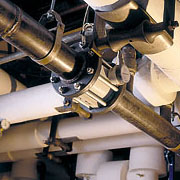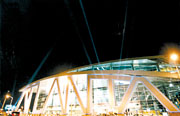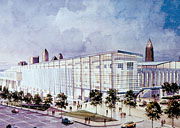
Atlanta, host of this year's AHR Expo and ASHRAE Winter Meeting, has come a long way from its humble beginnings as a railroad outpost in 1837 to the thriving, high-tech city it is today. Even after it was destroyed during the Civil War, determined citizens returned to the city, as it smoldered, ready to rebuild. This spirit - resolve - is alive and well in today's modern Atlanta.
The city is home to 400,000 people, Fortune 500 companies, banks, and industry, as well as famous corporate residents CNN and Coca-Cola. Famous citizens included civil rights leader Martin Luther King, Jr., who was born in Atlanta, and Pulitzer Prize-winning author Margaret Mitchell, who also set her epic novel, "Gone With The Wind" in the city.
Atlanta's place as the leading city of the Southeast is firmly established. It is this leadership and innovation that is reflected in the hvac design of three major buildings - a renovation, new construction, and an expansion - that represent the spirit of the south: The Ritz-Carlton, Atlanta; Philips Arena, home of the NBA's Atlanta Hawks; and the site of the 2001 AHR Expo, the Georgia World Congress Center.
The Ritz-Carlton, Atlanta
The Ritz-Carlton, Atlanta recently underwent its first major renovation since it opened in 1984. Boasting a 73% occupancy rate, the downtown landmark is 350,000 sq ft and 25 stories high, with a total of 444 rooms.
The renovation was undertaken because the previous system was no longer energy efficient and had reached the end of its useful life. One component of the $12 million project included boiler replacement, and the owners of the hotel decided on a modular, "ready to roll" solution that would not require a lot of external equipment. Other considerations included the local availability of parts and ease of maintenance. Also, since the hotel is located in downtown Atlanta, a boiler with a forced-draft system was needed so that downdrafts from surrounding buildings would not come into the hotel.

Contracting For Performance
The Ritz-Carlton, Atlanta purchased the six Thermal Solutions (Lancaster, PA) EVH2000 boilers under a performance contract from Smith Energy Management (Parrish, FL). Smith Energy worked with Thermal Solutions to specify the boilers, and it quoted a price for the entire system.The ten-year agreement guarantees the hotel a specific rate of energy savings over the period. The contract also allowed the hotel to correctly budget for the project. According to Bob Smith, owner of Smith Energy Management, his firm services equipment and provides an annual inspection; however, the Ritz-Carlton, Atlanta chose to service the equipment themselves.
The project, design, removal of old system, installation, and startup, took approximately eight to nine months. A potential problem had to be worked out first, however. The boiler room was located on the third floor and was quite small. The old boilers had to be cut out of the room with a welding torch, and then the big pieces were moved on to the roof. A hoist then lifted them off. Space limitations led Smith to choose the 2MMBtu input boilers. "The Thermal Solutions EVH2000 boilers have the smallest footprint available for the given Btu's. Because the hotel's hallways are narrow and the boiler room is small, this is the only boiler that we could have used based on energy efficiency requirements and space considerations," Smith said. The boilers measure 28 by 30 by 915/8 in.
Nelson O'Kelly, the hotel's director of engineering, supported the decision to use modular boilers. "The concept of a modular boiler is great. If you have a problem with one, it rolls over to another. It gives you a buffer. We haven't been out of hot water once," he said.
Additionally, a gas meter was installed on the line that services the boilers, so facility engineers can keep track of energy costs. This is in contrast to having simply an overall picture of the energy consumption in the entire building.
Other firms involved in the renovation include Mechanical Products, Inc. (Lawrenceville, GA), a manufacturer's rep firm for the mechanical hvac, plumbing, and industrial markets; and Ostrum Boiler, the installing contractor for the boiler replacement.
Besides the tight fit in the boiler room, no other surprises popped up. "The installation went very smoothly. One reason is because all of the parties involved worked so well together. We were pleased to be able to complete the job without undue interference with the hotel's operations," said Smith.

Results
Before the renovation, the Ritz-Carlton, Atlanta was in the bottom one-third in energy efficiency of all Ritz-Carlton hotels. After the installation of the new boilers, the Ritz-Carlton, Atlanta has moved into the top one-third. As an added bonus to increased energy efficiency, the boilers require little maintenance. "These boilers are so easy to maintain, and simplicity was a key to getting the project," said Rob Freeman, president of Mechanical Products, Inc.Philips Arena
Philips Arena, a 20,000-seat mixed-use facility located in downtown Atlanta, was built on the site of the Omni Arena, which it replaced. The arena, which opened in September 1999, is home to the NBA's Atlanta Hawks, the NHL's Atlanta Thrashers, and is host to concerts, conventions, and other special events.
The $213 million building placed first in the Building Systems Category for the 2000 American Consulting Engineers Council (ACEC), Colorado Chapter, Engineering Excellence Awards. Mechanical and electrical consulting firm M-E Engineers, Inc. (Wheat Ridge, CO) provided the mechanical, electrical, plumbing, sports lighting, interior façade lighting, telecommunications systems, and ice floor design for the facility, with Ted Prythero as the principal-in-charge. HOK Sport (Kansas City, MO) was the architect of record for the project.

Unique Requirements
For hockey games, the arena seats 18,570; for basketball games, the arena seats 19,928; and for concerts, there are 21,000 seats. In addition, the venue offers 83 luxury suites, five party suites, four restaurants/lounges, and the Hawk Walk concourse, which links the arena to the CNN Center next door. Additionally, the owners wanted the arena to be environmentally integrated with the 30-million-cu-ft CNN Center atrium, to which the arena is attached, with limited temperature and humidity control.Viewing sporting events requires symmetrical seating, especially if television cameras carry the action; an unobstructed view is needed.
It was the mixed-use requirement that made the project so challenging. Temperature control for hockey games is different than for basketball games, and different still for concerts. M-E Engineers' Mike Day, P.E. served as mechanical project manager. He reports that the NHL standards for optimum rink conditions are in the range of 64°F/44% rh and 68°/50% rh. The mission, therefore, was for M-E Engineers, Inc. to design a cost-effective method to maintain optimum conditions using Atlanta's humid air. The system that was ultimately installed subcools the air to 42° using 36° chilled water, then reheats to meet the cooling and heating requirements.
"It was a challenge to take the symmetrical design requirements of the hvac and lighting systems, and fit them into an asymmetrical seating bowl," Day said. Rob Stephens, P.E., M-E Engineers, Inc., electrical project manager, had the difficult challenge of incorporating a lighting scheme that would meet the stringent requirements of NBA and NHL broadcasts.
Other features of the system include a 100% outside air economizer capability and variable-air flow pumping.
According to Day, York International (York, PA) provided the 2,700-ton chilled-water system, and two 7,000 MBtuh Cleaver/Brooks (Milwaukee) dual-fuel boilers with Gordon-Piatt (Winfield, KS) burners provide the heating and domestic hot water. "Three hundred sixty thousand cfm of air is delivered to the seating bowl from custom air handlers provided by M&I in Ontario, Canada," he adds.
The mechanical systems were installed by a joint venture of McKenney/Mallory and Evans, Atlanta-based contractors.
The old Omni was a downtown landmark for many years. But now, thanks in part to the system's subsequent performance, patrons are enjoying the state-of-the-art Philips Arena in comfort, whether they're following pucks, balls, or bands.
Georgia World Congress Center
The Georgia World Congress Center opened in 1976 with a 350,000-sq-ft exhibition hall, 90,000 sq ft of meeting rooms, and a 2,000-seat auditorium. Almost immediately, plans were formulated for expanding the center.
Subsequent phases have included doubling the size of the original facility and adding exhibit space. After completion of Phase III, the complex had grown to include Centennial Olympic Park and the Georgia International Plaza, and it reopened in time for the 1996 Summer Olympics.
Phase IV will add 420,000 sq ft of exhibit space; a 27,000-sq-ft-ballroom; 75,000 additional sq ft of meeting space; connection to the adjacent Georgia Dome; and increased public circulation space for registration and prefunction activities. After construction on Phase IV is completed around July 2002, the expansion will give the Congress Center/Georgia Dome close to 1.5 million sq ft of exhibit space.

Phase IV In Motion
According to Jay D. Thompson, AIA, Thompson, Ventulett, Stainback & Associates, Inc., project principal, the new equipment for the $224 million expansion for Phase IV includes a central chilled water plant, central boiler plant, air-distribution systems including air-handling units and ductwork, and controls with facility management capabilities. Thompson Company, Inc. (Atlanta) is handling the mechanical engineering duties. The architects on the project are a joint venture between Heery International and Thompson, Ventulett, Stainback & Associates, Inc., both of Atlanta. Turner Associates (Atlanta) is the associated architect of the project.The goal of Phase IV is to connect the hvac systems with systems added in previous phases, while designing and specifying equipment using the latest technology available. New distribution systems will be extended to accomplish this.
"One interesting element of the hvac design for Phase IV is the connection of the Phase IV physical plant with the physical plants of Phases II and III. This interconnection provides us with tremendous flexibility in operating systems in a cost-effective manner while maintaining comfort for our visitors," said Kevin Clark, member of the Georgia World Congress Center project team.
Location Is Everything
All major cooling and heating machinery is located in one central plant, which will house the chillers, boilers, and associated equipment. This was done to keep open possible future connections to the nearby Georgia Dome and to streamline operations and maintenance in the future, thereby making maximum efficiency of operation and maintenance possible, said C. Andrew McLean, FAIA, senior principal in charge of the project.The chillers and boilers will be located on the ground level. The pumps, water heaters, and other support equipment will be located on an elevated floor above the ground level. The cooling towers will be located on the roof of the central plant.
The custom air-handling units will have chilled and heating water coils arranged in preheat cooling and reheat positions with the preheat coil being in the outside air stream. The central station units will have preheated coils located in the outside air ducts leading to the units.
Inside the chilled water plant will be the chilled water generating and pumping equipment, including chillers, pumps, expansion tanks, and related piping, valves, and accessories. Five centrifugal, high-efficiency chillers consisting of five 1,100-ton machines provided by Carrier Corporation (Syracuse, NY) will provide cooling. As mentioned, the chilled water piping will be interconnected with the existing chilled water plants constructed under Phases I, II, and III to enable load sharing between all aspects of previous phase construction, said Thomson.
The boiler plant will house all of the hydronic heating equipment including four fire-tube, forced-draft Scotch Marine boilers by Cleaver-Brooks with a capacity of 495 hp each.
Thus, even after visitors to this year's Expo return home after making use of the complex's first three phases (and possibly the Ritz-Carlton or Philips Arena as well), Atlanta will continue adding to its tradition of building, and rebuilding, on its past. ES
